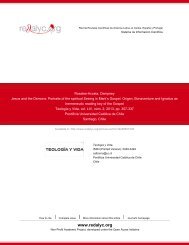A Key Concept in Modern Translation Theory - Redalyc
A Key Concept in Modern Translation Theory - Redalyc
A Key Concept in Modern Translation Theory - Redalyc
You also want an ePaper? Increase the reach of your titles
YUMPU automatically turns print PDFs into web optimized ePapers that Google loves.
SERGIO BOLAÑOS CUELLAR<br />
81<br />
text itself but also the conditions and determ<strong>in</strong>ants of the SL-text production and<br />
those of the TL-text reception. Our work<strong>in</strong>g hypothesis for analyz<strong>in</strong>g (describ<strong>in</strong>g,<br />
classify<strong>in</strong>g, expla<strong>in</strong><strong>in</strong>g) translation equivalence is that it is a text-bound relation<br />
which is l<strong>in</strong>guistically realized <strong>in</strong> texts and whose only tangible, empirically<br />
apprehensible form is the SL and TL texts. Therefore our po<strong>in</strong>t of departure and<br />
arrival is always a text. Obviously conditions and determ<strong>in</strong>ants of the translation<br />
communicative process should be taken <strong>in</strong>to account as a resource to resort to<br />
when necessary but not as a perennial limbo of speculation which drives one<br />
away from the source language text or highlights excessively the role played by<br />
the translator.<br />
<strong>Translation</strong> equivalence as envisaged <strong>in</strong> our DTM could have immediate<br />
impact on the work of the professional translator by help<strong>in</strong>g him solve (=def<strong>in</strong>e,<br />
describe, analyze, expla<strong>in</strong>) translation problems, on teach<strong>in</strong>g translation as an<br />
<strong>in</strong>ter-subjective activity where clear parameters can be established as to what<br />
may count as a translation, and on the field of translation criticism as it would<br />
help to avoid simplistic, impressionistic (=biased) critiques of translations. In this<br />
respect we have already used our equivalence-related DTM (Bolaños 1998) for<br />
analyz<strong>in</strong>g the translation of a literary text, El coronel no tiene quien le escriba,<br />
a novella by Gabriel García Márquez. This is a translation case, as are literary<br />
texts <strong>in</strong> general, where supposedly no textual equivalences could be actually<br />
established and, therefore, analyzed. Our <strong>in</strong>itial premise is that no sound translation<br />
critique can be carried out if the whole text is not analyzed. The f<strong>in</strong>al judgment<br />
as to the translation quality as a whole should be made <strong>in</strong> terms of weaknesses<br />
and strengths of the analyzed translated text. By us<strong>in</strong>g a metaphor one would<br />
say that the translation product is like a wave: it has peaks and troughs. The ideal<br />
case would be a straight l<strong>in</strong>e, but it is ideal precisely because there are no absolute<br />
equivalences, that is, 1:1 <strong>in</strong>ter-textual (SL-text and TL-text) equivalences.<br />
However, one should be able to determ<strong>in</strong>e when a peak or a trough has just gone<br />
off boundaries, i.e. when the translation equivalence is off the limits of the<br />
l<strong>in</strong>guistically possible and textually realizable equivalence range. As a brief and<br />
partial illustration of how one can use DMT to assess a translation, one can<br />
analyze the <strong>in</strong>itial paragraphs of García Marquez’ novella with the correspond<strong>in</strong>g<br />
English and German translations:<br />
El coronel no tiene quien le escriba (Bogotá, Norma 1961/1996)<br />
El coronel destapó el tarro del café y comprobó que no había más de una<br />
cucharadita. Retiró la olla del fogón, vertió la mitad del agua en el piso de tierra,<br />
y con un cuchillo raspó el <strong>in</strong>terior del tarro sobre la olla hasta cuando se desprendieron<br />
las últimas raspaduras del polvo de café revueltas con óxido de lata.
















